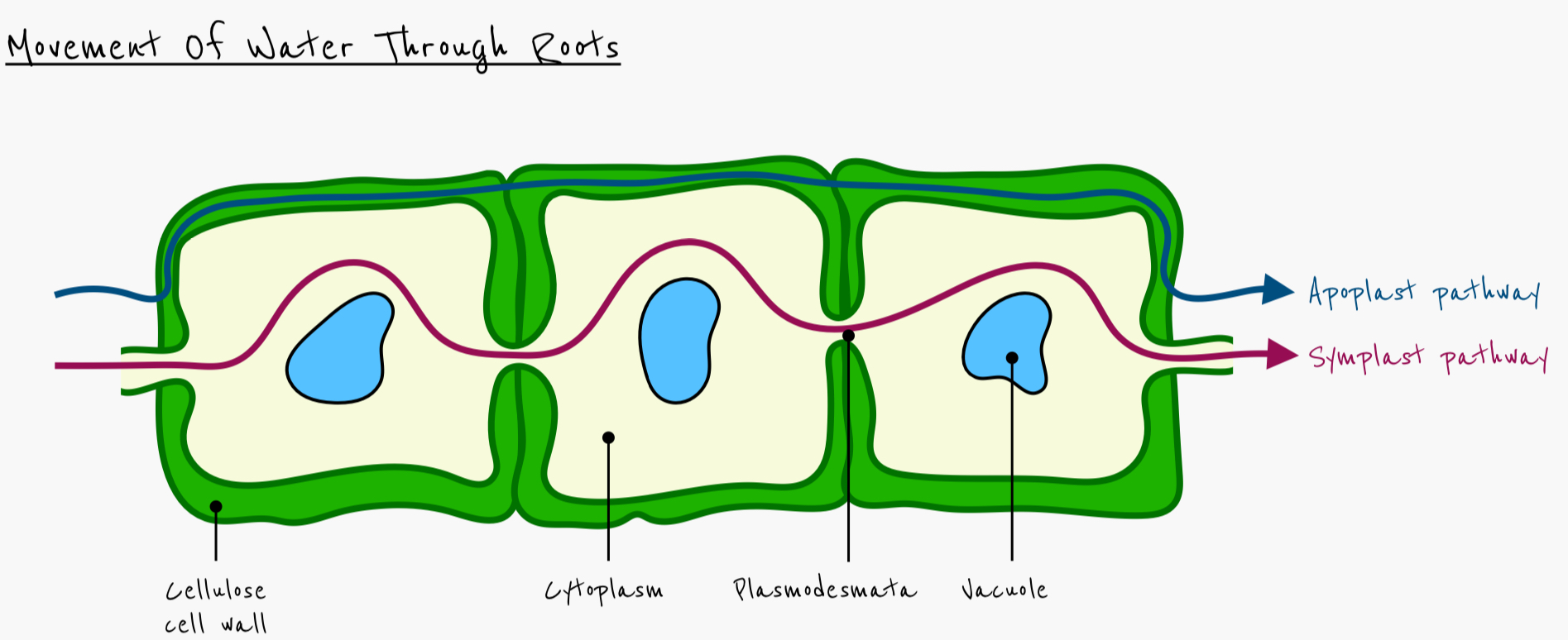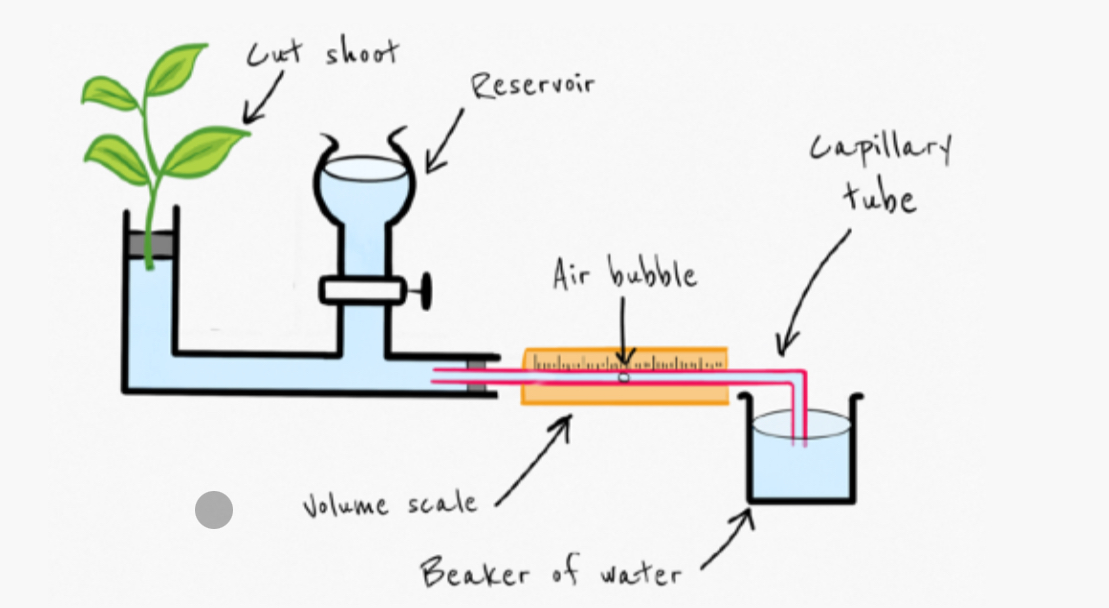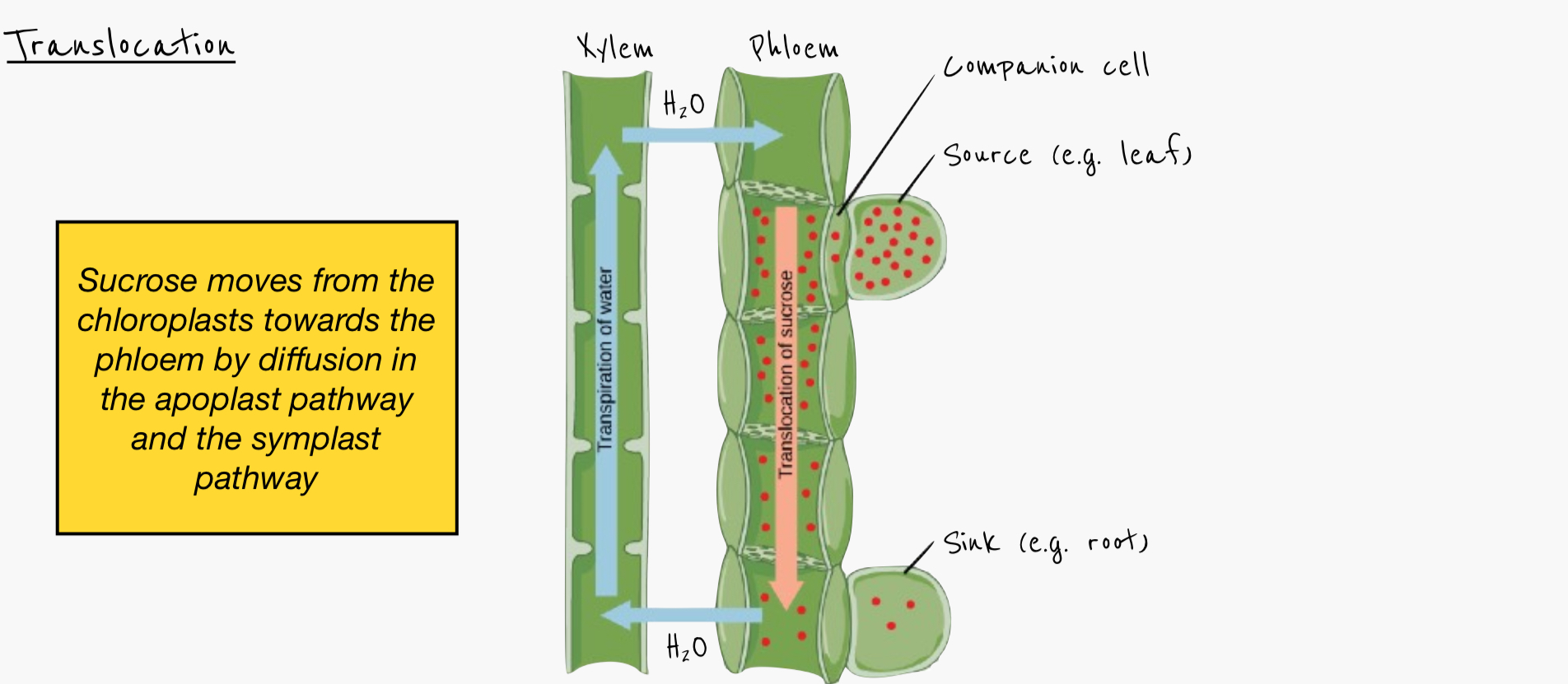Transport mechanisms
1/40
Earn XP
Description and Tags
Name | Mastery | Learn | Test | Matching | Spaced |
|---|
No study sessions yet.
41 Terms
Why is water important for plants
provides turgor/hydrostatic pressure
Gives support to stems
Provides force for roots to push through ground
Loss of water helps keep plants cool
Mineral ions and sugars are transported in aqueous solutions
Required for photosynthesis
How are mineral ions absorbed by roots
by root hair cells
Against concentration gradient
Requires active transport - protein pumps and ATP
Large number of mitochondria found near membrane of root hair cells
What are some mineral ions absorbed by roots
potassium
Phosphates
Nitrates
How is the surface area for absorption of minerals ions increased
Branching of roots
Root hair cells
How does water enter root hair cells
Osmosis - higher water potential in soil and lower in cell due to dissolved mineral ions, sugars amino acids
Define plasmodesmata
Continuous cytoplasm channels that link plant cells
What are the two pathways that water uses to move through the root
symplastic pathway
Apoplastic pathway

Describe the symplastic pathway
water moves through cytoplasm
By osmosis
Plasmodesmata link adjacent cells
Water potential gradient maintained by water leaving roots and entering xylem
Describe the apoplastic pathway
Water moves through the cell walls and intercellular spaces
Gaps between cellulose fibres filled with water
Cohesive forces pull water molecules along
Creates tension, so continuous flow of water forms
What is the casparian strip
a band of suberin (waxy material) and lignin
Lines cells in endodermis
Provides waterproof layer around xylem
What is the role of the casparian strip
prevents water moving through the apoplast pathway
Forces water into symplastic pathway
How does water enter the xylem
water in apoplastic pathway forced into symplastic pathway by casparian strip
Water must pass through cell membranes to enter cytoplasm
Cell membranes are selectively permeable - prevents toxic solutes entering cells
Mineral ions actively transported into xylem
Water follows through endodermis by osmosis down the water potential gradient
Known as root pressure
Define transpiration
evaporation of water vapour from the surface of mesophyll cells
Water vapour lost through stomata by diffusion
What is a potometer used to measure
The rate of water uptake
Describe how a potometer is set up
cut stem at an angle under the water to avoid introducing air bubbles
Dry the leaves
Seal joints with petroleum jelly
Measure the distance moved by the air bubble over a set period of time (eg one minute)
Repeat/do again the measurements for reliability

Define transpiration stream
movement of water up xylem vessels
From roots to leaves
What is the role of a transpiration stream
cools plants
Delivers water and mineral ions to leaves
Provides support
Which properties of water enable it to form a transpiration stream
hydrogen bonding and polarity of water molecules
Water molecules are cohesive with others
Adhesion between water and xylem walls
Describe how a transpiration stream occurs
cohesion - hydrogen bonding between water molecules
Adhesion - hydrogen bonding between water and xylem walls
As water vapour is lost through evaporation, more is drawn up from below
Water evaporates from mesophyll cells Mineral ions walls into intracellular air spaces - creates tension
Due to cohesive properties of water and lower pressure at top of xylem
Explain how tree diameter provides evidence for the cohesion-tension theory
Tree diameter is smaller during the day
Rate of transpiration at its highest
Tension in xylem vessels at its highest
Pulls stem/trunk inwards
Explain how broken xylem vessels provide evidence for the cohesion-tension theory
When a xylem-vessel breaks, air is drawn in
Plant can no longer move water up the stem
Continuous stream of water is broken
How is water carried from the roots to the leaves using cohesion tension theory
water moves into xylem down a water potential gradient
Root pressure at bottom of xylem helps push water up
Diffusion of water vapour from stomata creates low pressure at top of xylem
Creates tension in xylem
Water molecules are cohesive due to hydrogen bonds
Water column pulled up by tension
Adhesion of water molecules to xylem walls help support column
How does water travel from leaves to the stomata
Through apoplastic and symplastic pathways
What controls the opening and closing of stomata
Guard cells
How can plants control water loss
opening and closing of stomata
When environmental conditions are favourable, solutes actively pumped into guard cells
Water follows by osmosis
Increase in hydrostatic pressure makes guard cells become bean shaped and stomata to open
How are guard cells adapted for their role
Unevenly thickened cell wall
Wall beside pore is thicker, allowing guard cells to bend
Transport proteins present in plasma membrane
Chloroplasts and mitochondria to provide ATP
Why is transpiration unavoidable during the day
stomata are open to allow gas exchange
Required for photosynthesis
Water vapour leaves leaf down water potential gradient
Higher temperatures during the day cause greater evaporation
What are the factors affecting rate of transpiration
light intensity
Temperature
Humidity
Wind speed
Explain how a rise in humidity affects the rate of transpiration
Less transpiration
Air spaces inside leaf are nearly saturated with water vapour
Smaller concentration gradient with higher atmospheric humidity
Explain how a rise in temperature affects the rate of transpiration
more transpiration
More kinetic energy of water molecules
Faster evaporation rate
Explain how a rise in wind speeed affects the rate of transpiration
More transpiration
water vapour blown away from the leaf
Increasing the concentration gradient of water vapour
Explain how a rise in light intensity affects the rate of transpiration
More transpiration
light causes stomata to open
Low carbon dioxide concentration inside leaf in bright light so stomata open wider
What are xerophytes
Plants adapted to live in very dry conditions (eg. Deserts)
like cacti or marram grass
Describe and explain how xerophytes are adapted for life in deserts
thick and waxy cuticle - reduces water loss by transpiration
Spines instead of leaves (or curled leaves) - reduces water loss by transpiration
Stomata open only at night - reduces rate of transpiration
Sunken stomata (in pits) to increase humidity - reduces water potential gradient
Long, shallow root systems - absorbs more water
Succulents - stores water in specialised tissue in stems and roots
Hairs on leaves (trichomes) - reduces air flow near leaf to trap water vapour
Reduces water potential gradient
Define translocation
Movement of organic compounds (eg sucrose, amino acids) from sources to sinks
What is a source (+examples)
A site where loading of sugars and amino acids into sieve tubes of phloem occurs
Occurs where organic compounds are synthesised
Eg leaves - where photosynthesis occurs
What is a sink (+examples)
Where assimilated are unloaded for use or storage (eg roots, fruits and seeds)
Explain how sucrose is loaded into the phloem sieve tubes elements
Protons (H+) are pumped out of companion cells into cell wall by active transport creating a proton gradient
Protons diffuse back into companion cells down the concentration gradient attached to sucrose molecules
Protons and sucrose flow through co-transporter proteins in membrane by facilitated diffusion
Sucrose is moved from mesophyll cells against its concentration gradient (polar so can’t cross membrane)
Sucrose diffuses into sieve tubes elements via plasmodesmata (and amino acids)

Explain how water moves in the phloem
High concentration of solutes in phloem sieve tubes at source
Leads to water uptake from xylem by osmosis
Hydrostatic pressure increases
Low concentration of solutes in phloem sieve tubes at sink
Water moves back into xylem by osmosis
Hydrostatic pressure decreases
Water moves down the hydrostatic pressure gradient due to its incompressibility
Describe in detail the transport of organic compounds/translocation in vascular plants
phloem transports organic compounds
From sources to sinks
Through sieve tubes elements via
H+ ions actively transported out of companion cells into cell walls
Sucrose and H+ ions diffuse back into phloem through co-transporter proteins (loading)
High solute concentration causes water to enter by osmosis at source
High hydrostatic pressure causes glow from source to sink
Solutes diffuse out of phloem into sink
Water moves back out of sieve tubes elements by osmosis
How is glucose produced in photosynthesis transported and stored in plants
Glucose transformed to sucrose
Translocation of sucrose by phloem - active process
Sucrose moves from source (photosynthetic tissue - leaves) to sink (fruits/seeds/roots/storage organs)
Sucrose converted to starch
Stored in storage organs/roots/tubers